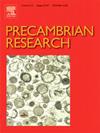Neoproterozoic accretionary tectonics of the northern Yangtze Block: Constrains from the geochemistry and geochronology of the volcanic-sedimentary succession
IF 3.2
2区 地球科学
Q2 GEOSCIENCES, MULTIDISCIPLINARY
引用次数: 0
Abstract
The unclear tectonic evolution of the northern margin of the Yangtze Block during the middle Neoproterozoic impedes our comprehensive understanding of the breakup of the supercontinent Rodinia. The Suixian volcanic-sedimentary group in the South Qinling Belt is crucial for elucidating this issue. This study presents a comprehensive investigation of volcanic rocks within the Suixian Group, utilizing zircon U-Pb geochronology and Hf isotope analysis, whole-rock major and trace element analysis, as well as Sr-Nd isotopic analysis. The geochemical characteristics indicate that the mafic volcanic rocks exhibit three distinct types. The first type resembles island arc basalts, enriched in large ion lithophile elements and depleted in high field strength elements, with positive εNd(t) values, suggesting derivation from mantle metasomatized by subduction-related fluids. The second type displays high Nb values and geochemical characteristics akin to Nb-enriched basalts, possibly linked to slab window tectonics. The third type possesses an E-MORB-like trace element composition and positive εNd(t) values, resembling basalts formed during back-arc extension. Felsic volcanic rocks from the Suixian Group yield zircon U-Pb ages of 747 ± 5 Ma, 743 ± 4 Ma, and 742 ± 5 Ma. These felsic rocks belong to the calc-alkaline to high-K calc-alkaline series and are characterized by enrichment in large ion lithophile elements and depletion in high field strength elements. Zircon Hf isotopic analyses reveal that the felsic rocks exhibit heterogeneous εHf(t) values ranging from -9.2 to -1.0, indicating formation by partial melting of the lower crust triggered by mantle-derived magma. Combined with geological features of the Suixian Group and previous detrital zircon U-Pb geochronological studies, we infer that the formation of the Suixian Group can be attributed to a multistage process encompassing the subduction of oceanic slab in the early stage and subsequent back-arc extension, further confirming a sustained subduction-accretion tectonic setting along the northern margin of the Yangtze Block during the middle Neoproterozoic.
扬子地块北部新元古代增生构造:来自火山-沉积演替的地球化学和年代学约束
扬子地块北缘新元古代中期构造演化的不明确,阻碍了我们对罗迪尼亚超大陆分裂的全面认识。南秦岭遂县火山-沉积群对阐明这一问题具有重要意义。本文采用锆石U-Pb年代学、Hf同位素分析、全岩主微量元素分析、Sr-Nd同位素分析等方法,对遂县群火山岩进行了综合研究。地球化学特征表明,基性火山岩具有三种不同的类型。第一类玄武岩类似岛弧玄武岩,富集大离子亲石元素,贫高场强元素,εNd(t)值为正,表明其来源于俯冲流体交代的地幔。第二种类型具有高铌值和类似富铌玄武岩的地球化学特征,可能与板块窗构造有关。第三类具有e - morb型的微量元素组成和正的εNd(t)值,类似弧后伸展时期形成的玄武岩。绥县群长英质火山岩的锆石U-Pb年龄分别为747±5 Ma、743±4 Ma和742±5 Ma。这些长英质岩石属于钙碱性—高钾钙碱性系列,具有大离子亲石元素富集、高场强元素亏缺的特点。锆石Hf同位素分析表明,长英质岩石的εHf(t)值在-9.2 ~ -1.0之间呈非均质分布,表明地幔源岩浆引起下地壳部分熔融形成。结合绥县群地质特征和前人碎屑锆石U-Pb年代学研究,认为绥县群的形成可归因于早期洋板俯冲和弧后伸展的多阶段过程,进一步证实了新元古代中期扬子地块北缘持续的俯冲-增生构造背景。
本文章由计算机程序翻译,如有差异,请以英文原文为准。
求助全文
约1分钟内获得全文
求助全文
来源期刊

Precambrian Research
地学-地球科学综合
CiteScore
7.20
自引率
28.90%
发文量
325
审稿时长
12 months
期刊介绍:
Precambrian Research publishes studies on all aspects of the early stages of the composition, structure and evolution of the Earth and its planetary neighbours. With a focus on process-oriented and comparative studies, it covers, but is not restricted to, subjects such as:
(1) Chemical, biological, biochemical and cosmochemical evolution; the origin of life; the evolution of the oceans and atmosphere; the early fossil record; palaeobiology;
(2) Geochronology and isotope and elemental geochemistry;
(3) Precambrian mineral deposits;
(4) Geophysical aspects of the early Earth and Precambrian terrains;
(5) Nature, formation and evolution of the Precambrian lithosphere and mantle including magmatic, depositional, metamorphic and tectonic processes.
In addition, the editors particularly welcome integrated process-oriented studies that involve a combination of the above fields and comparative studies that demonstrate the effect of Precambrian evolution on Phanerozoic earth system processes.
Regional and localised studies of Precambrian phenomena are considered appropriate only when the detail and quality allow illustration of a wider process, or when significant gaps in basic knowledge of a particular area can be filled.
 求助内容:
求助内容: 应助结果提醒方式:
应助结果提醒方式:


